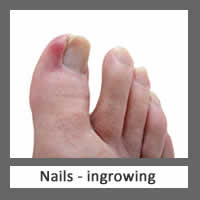APPOINTMENTS are now AVAILABLE with safety measures in place to welcome you back safely please call or text 07864606654
please ask about our safety measures to mitigate the virus.
01449 675600 | Email: appointments@pairoffeet.com.
APPOINTMENTS are now AVAILABLE with safety measures in place to welcome you back safely please call or text 07864606654
please ask about our safety measures to mitigate the virus.
01449 675600 | Email: appointments@pairoffeet.com.
Nails - ingrowing

Following
a daily routine to keep your feet clean and free from infection
will help prevent potential foot problems.
Wash
your feet every day in warm soapy water (don't soak them, as this
might destroy the natural oils) and dry thoroughly, especially
between the toes.
If
you can see and reach your feet cut them after a bath when the toe
nails are softer. Trim your toe nails regularly, using proper nail
clippers. Cut straight across, not too short, and not down at the
corners as this can lead to in-growing nails. File them, if that is
easier.
Any
minor cuts or abrasions should be covered with a clean dry
dressing, and blisters should be left to dry out on their own. If
they burst, apply a clean dry dressing, but do not burst them
yourself.
Seek
professional treatment if they do not heal quickly. Wounds
(sometimes called ulcers) should be assessed and treated as a
matter of urgency within 24hours, especially if there is redness or
swelling around the area, or were you have previously been warned
to seek immediate attention.
Causes:
Ingrown toenails develop for many reasons. In some cases the condition is congenital, such as toenails that simply are too large. People whose toes curl, either congenitally or from diseases like arthritis, are prone to ingrown toenails. Often trauma, like stubbing a toe or having a toe stepped on, can cause a piece of the nail to be jammed into the skin.
Repeated trauma, such as the pounding to which runners typically subject their feet, also can cause ingrown nails.
The most common cause is cutting your toenails incorrectly, causing them to re-grow into the skin. Tight hosiery or shoes with narrow toe boxes only make matters worse. If the skin is red, painful or swollen on the sides of the nail, an infection may be present. This occurs because the ingrown nail is often in a warm, moist and bacteria-rich environment. When the nail penetrates the skin, it provides a convenient entry for germs that can cause infection.
Untreated, the nail can go under the skin, causing a more severe infection. In either case, the infection needs to be cured with sterile instruments and antibiotics.
Ingrown toenails should be treated as soon as they are recognized. In many cases, people with uninfected ingrown toenails can obtain relief with the following simple regimen:
Cutting toe nails properly goes a long way toward the prevention of ingrown toenails. Using a safety nail clipper, cut the nails straight across, so that the nail corner is visible. If you cut the nail too short, you are inviting the nail corner to grow into the skin. It is the natural tendency, when the edge of the nail starts to grow in, to cut down at an angle at the nail edge, to relieve the pain.
This does relieve the pain temporarily, but it also can start a downward spiral, training the nail to become more and more ingrown.
Stowmarket podiatrists (Chiropodists) are all HCPC Registered and Members of the Royal College of Podiaitrists. ( Chiropodists) Only HCPC registered practitioners (Previously known as State Registered) are by law allowed to use the Protected titles:
Chiropodists & Podiatrists
Please be aware
Foot Health Practitioners are not Podiatrists or Chiropodists .
CHECK THE HCPC to confirm the person looking after your feet is HCPC Registered and allowed to use the title Podiatrist or Chiropodist
Feel free to check registration details by click on the HCPC logo and enter the Practitioners name and profession
We use professional medical equipment and sterilsed instruments & wear PPE throughout your treatment.
Royal College of Podiaitry
The Royal College of Chiropodists and Podiatrists is the largest independent professional body in the UK and represent HCPC Registered chiropodists /podiatrists.Previoiusly known as The Society of Chiropodists
State Registered Nurses ,Chiropodists Physiotherapists etc are no longer known as State Registered but as HCPC Registered Practitioners
"Mrs Raven is a miracle worker, I saw someone else for 3 years with no successfull outcome, had 3 visits to Mrs Raven and my foot problems have all cleared up".
'Jacquie Capon is very professional and thorough"
Rochelle Kemp makes my feet feel great and I look forward to my treatments her experience with diabetic treatments is impressive .
Chloe Waters understood a my foot issue and gave me a lot
of useful information and is very gentle and thorough .
"I'm walking on air, Thanks to Stowmarket Chiropody"
Telephone or text for appointments:
Email:
Our Clinic address is
The Arches, 47 Bury Street,
Stowmarket, Suffolk. IP14 1HD
Car
Parking:
A public car park is opposite the surgery. We are walking distance to the high st and train station
We have a shelter under cover for Patients to comply with Social distancing until called for their appointments if they prefer
Shielded patients and Blue badge holders are welcome to use our restricted car parking spaces and wait in their vehicles for safety
Please mention your needs when
booking.

T: 01449 675600 or call text 07864606654
E: appointments@pairoffeet.com
© Copyright. All Rights Reserved.
The Arches, 47 Bury Street, Stowmarket, Suffolk IP14 1HD